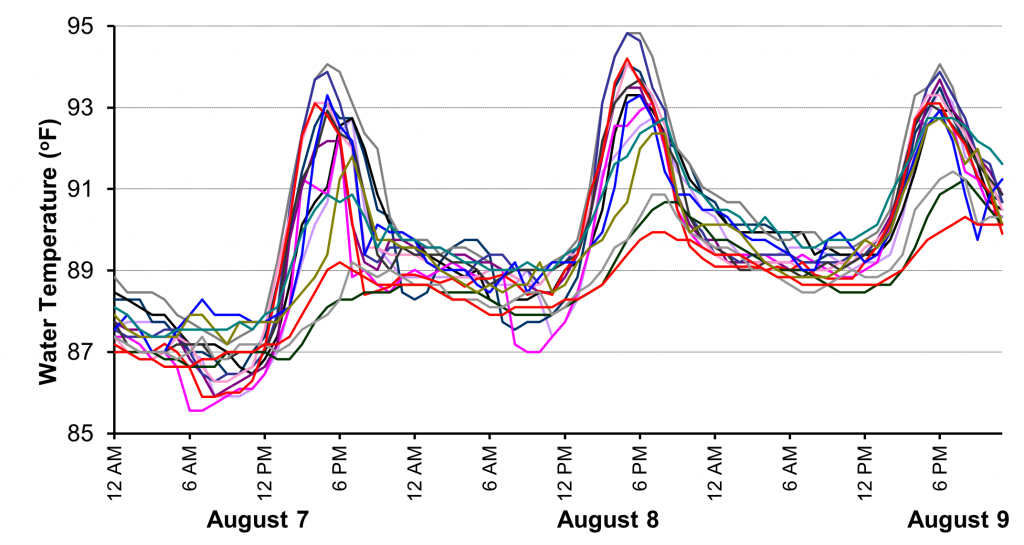Home » Projects » Shellfish Farm Environment Projects » Water Temperature Variability during Summer Months at Clam Aquaculture Lease Areas
Water temperature plays an important role in biology and directly affects the bodily functions of aquatic organisms necessary for growth and survival. It also influences water quality parameters, such as dissolved oxygen and pH. Currently, five water quality monitoring stations (CLAMMRS sondes) are located at lease areas around the state to provide timely information on water temperature and other parameters so clam farmers can make more informed decisions about crop management. These stations measure continuously at a depth of 6 inches above the bottom. The limited number of stations does not provide for an in-depth understanding of water temperatures across the lease areas or the influence of temperature on clam production.
The intent of this project was to provide both detailed and broad coverage of water temperatures by deploying inexpensive data loggers at multiple leases to adequately describe variability possibly due to water depth, substrate characteristics, currents, and other parameters.
The waterproof data loggers used for this project were small, about 2” long. Because of their size, they can be placed either inside of or attached to the outside of a clam bag on the lease site. This provides for temperature measurements at the same depth and location of the clams. From July through November of 2007, eight clam farmers placed data loggers on 17 leases in Cedar Key. Although this represents a small percentage of leases in the area, it was anticipated that the spread of leases used would provide useful information on temperature variability. In addition, temperature measurements were collected from the two CLAMMRS stations in the area.
Water temperature trends in 2007 appeared to be similar across the lease sites from month to month (Figure 1). Regardless of lease site, there was a rise in temperature through the day followed by a cooling during the night. The average difference in temperatures over a 24-hour period did not change from month to month (4.3°F in August versus 4.1°F in November). What did change was the average temperature recorded from month to month (88.3°F in August versus 68.0°F in November). Based on the data collected, significant differences in temperatures across the leases were observed on a day-to-day basis. This suggests to a grower that when comparing temperatures at different leases, it is more important to look at hourly changes as opposed to monthly trends. One factor influencing water temperature is depth. It is anticipated that information obtained from this monitoring project may be useful in determining planting and harvesting strategies during the summer months.
Peak water temperatures were recorded during the month of August, with the hottest temperature (94.8°F) recorded at two of the leases on August 8th at 5:00 PM (see figure below). This peak occurred one hour before a predicted low tide (+0.2’). Temperatures ranged from 89.4°F to 94.1°F on the other 15 leases at that time, representing over a 5°F difference. The CLAMMRS sondes also recorded peak water temperatures at that time (94.2°F). This becomes important as clams cease growth processes around 88°F, and stop filtering at temperatures above 90°F. Looking at water temperatures during the month of August at all leases, there were 26 days on which temperatures reached 88°F, and of those days, temperatures exceeded 90°F on 17 occasions. Also of note is that regardless of lease site, peak temperatures during the day were consistently recorded around 6 PM. This strongly suggests to growers in order to minimize stress and maximize clam survival and shelf life, farming activities should be conducted in the cooler morning hours when possible. The project provided a lot of useful information this year and should provide more in the coming years. In 2008, we increased the number of leases with 39 data loggers deployed and Corrigan’s Reef lease areas. These will be recovered in October.
Chuck Mulligan, Citrus County Academy of Environmental Sciences
Leslie Sturmer, UF/IFAS Shellfish Aquaculture Extension
USDA Hatch

Figure 1. Water Temperatures (oF) Recorded at 19 Leases in Cedar Key during August 7-9, 2007

